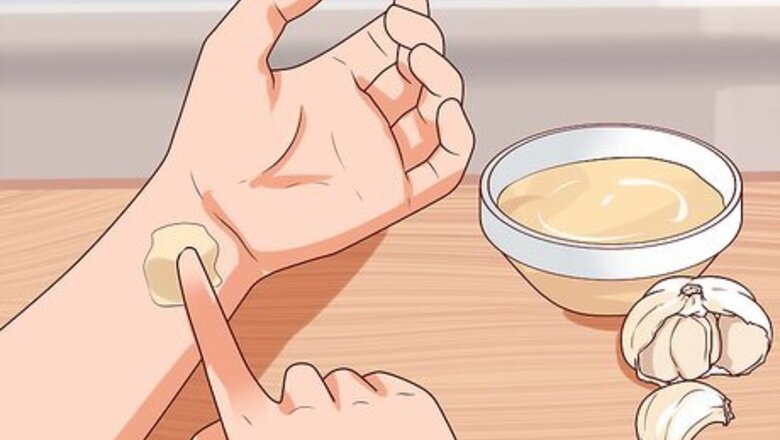
views
Treating Warts with Garlic
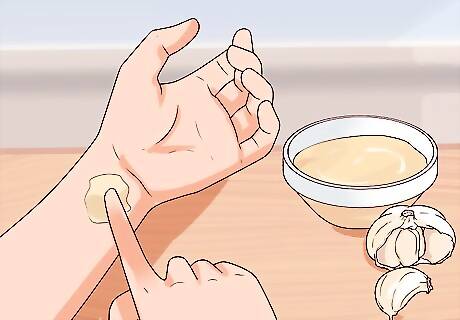
Test your skin. Garlic is a great home remedy for the common wart. Fresh garlic works the best, but you can also use garlic juice. Rub garlic into a small portion of your skin first to see if your skin is sensitive to the garlic. Some people can get a rash from fresh garlic. The rash is not dangerous, but it can be irritating. If this happens to you, you can still use the remedy, but the rash may persist. If you do, only leave the crushed garlic on for an hour at a time. It may also take longer to get rid of the wart. A study where children's warts were treated with garlic found that 100% of the warts were cleared with no significant side effects other than complaints of the smell and once instance of mild skin irritation. Another study used a lipid, or fat, extract of garlic on both warts and corns. They studied 42 patients of various ages and found 100% recovery in all the patients with the warts. It is believed that the main anti-viral component of garlic, a substance known as allicin, is the chemical which is working on warts, but little research to substantiate this claim has been done.
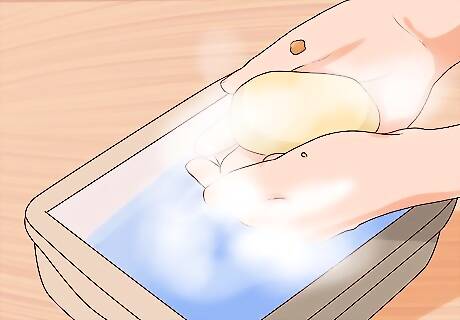
Prepare the area. Before you apply the garlic, you need to sanitize and dry the area of your skin with the wart. Wash your hands and then wash the area with the wart. Use warm soap and water. Dry the area with a cotton towel. Wash any cloth material that came into contact with the wart in hot, soapy water. You can also bleach the towels to make sure you kill off any wart virus.
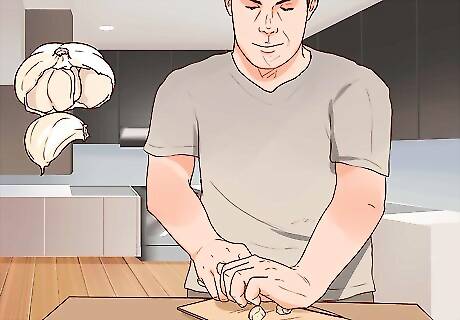
Apply the garlic. Take one clove of garlic and crush it with the flat part of a knife. You can also cut a clove of garlic in half. Rub the area with the crushed garlic or cut edge of the clove to let the juice sink in.
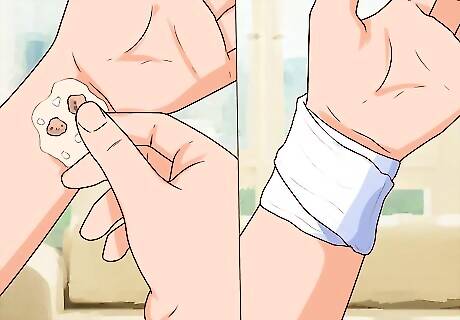
Wrap the area. Place the crushed garlic directly onto the wart. Cover the garlic and the wart with a bandage or, if you prefer, a piece of duct tape. Avoid placing the garlic on unaffected skin. Make sure you don't have any open cuts or wounds in the area. The garlic can burn and the wart virus may spread to the area.
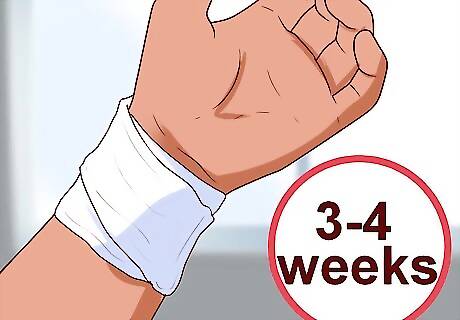
Repeat the treatment. The treatment does not work overnight. You need to repeat the process daily. Rewash and dry the wound. Apply fresh crushed or cut garlic to your wart. Cover the wart with the fresh garlic and always wrap the wound in a fresh bandage. You can also use duct tape to wrap the wound. This helps it stay dry. However, this can irritate other areas of your skin. Repeat the garlic remedy daily for at least 3-4 weeks. Most people begin to see the wart getting smaller within 6-7 days. It may look pruney and wrinkled after removing the bandage and washing away the garlic. It will also look paler than before. If you don’t see any improvement, see your physician to see if something else is going on.
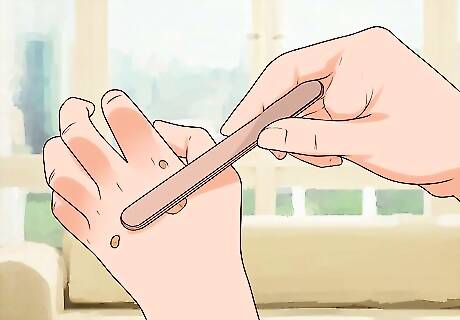
File away the excess skin. You can use an emery board to help file away the skin of a wart. Hold the area with the wart over the sink. Dampen the wart. Use the rougher side of the board and gently rub the top and sides of the wart. Next, turn the emery board over to the smoother side of the board. Repeat the same path as you did with the rough side. Rinse off the area, wash it, and re-apply the crushed garlic. Do not rub hard enough to draw blood. Also be careful not to touch any unaffected skin with the emery board. If you are dealing with a plantar wart, keep your foot over the bathtub or over a small plastic tub. Make sure and wash away any of the infected skin you have rubbed off. Wash everything in the sink or into the tub. You don't want to get re-infected. Throw away the used emery board.
Using Other Natural Methods
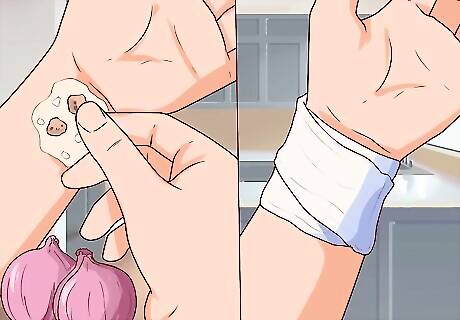
Use onions. Like garlic, you can use onions to help remove warts naturally. Take 1/8th of a medium sized onion and crush it. Place the onion directly on to the wart and cover with a bandage or, if you prefer, a piece of duct tape. Repeat, applying fresh onion every day, covering the wart with a fresh covering. As with the garlic method, use a disposable emery board to file away the excess skin of the wart between applications.
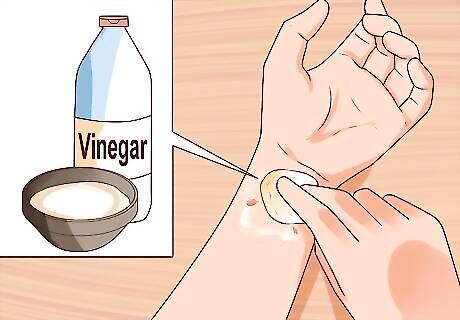
Soak the wart in vinegar. Vinegar is an acid, diluted acetic acid, and is thought to break down cell membranes. Then the acidic environment kills the virus. Soak a cotton ball in white vinegar and apply to the wart. Attach the cotton ball to the wart using duct tape. You can leave it on for 2 hours up to 2 days. Repeat as necessary. Between applications, use a disposable emery board to file away the skin.
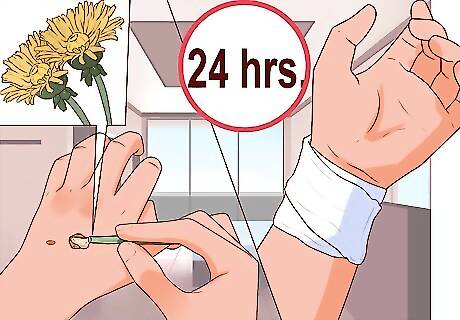
Use a dandelion. Dandelion sap contains a number of ingredients that help with warts, including anti-viral substances. These substances likely kill off the virus-infected cells. Pick a dandelion or two off your lawn. Break the stem and squeeze the dandelion sap onto the wart. Cover the wart with a bandage or duct tape. Leave it on for 24 hours. Repeat as necessary. Use a disposable emery board to file away the wart between treatments.
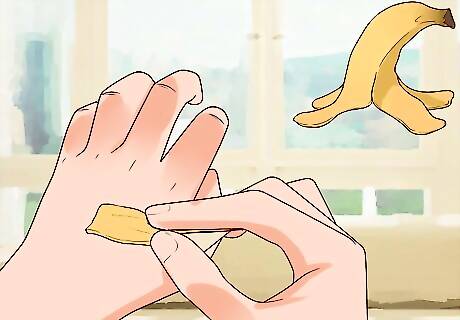
Apply banana peel. Banana peels contain a number of substances, including various enzymes that may break down the cell membrane. Place the banana peel with the inner part of the peel on the wart. Cover the peel with a bandage or duct tape and leave it on overnight. Repeat as necessary. In addition, banana peels contain carotenoids, which are the substances from which Vitamin A can be synthesized. Vitamin A has anti-viral effects. Between applications, use a disposable emery board to file away the wart.
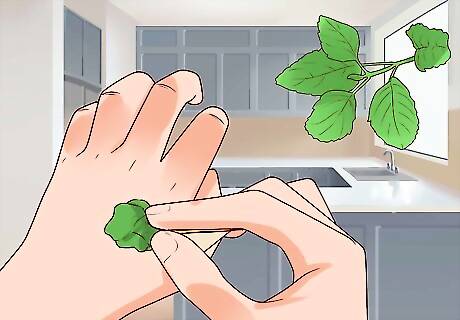
Try fresh basil. Basil has a number of anti-viral substances and that is believed to help basil kill off the wart virus. Cut a fresh basil leaf and ball it up. Place it over the wart. Cover the basil with a bandage or duct tape and leave it on for 24 hours. Repeat as necessary. Between applications, use a disposable emery board to file away the skin.
Using Over-the-Counter Remedies
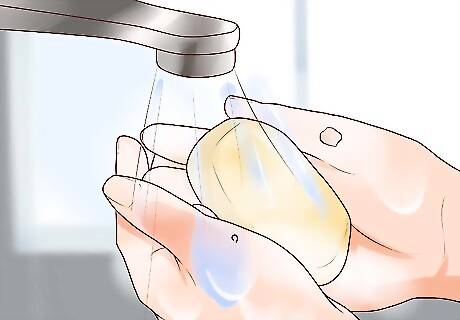
Prepare your skin. Regardless of the remedy you are using, always wash and dry your hands before and after touching a wart. You should limit the area of normal skin treated by any of the over-the-counter methods. These methods generally work within a few days. If your wart is not smaller or has not changed in appearance after 6-7 days, check with your healthcare professional. You may need another, stronger approach.
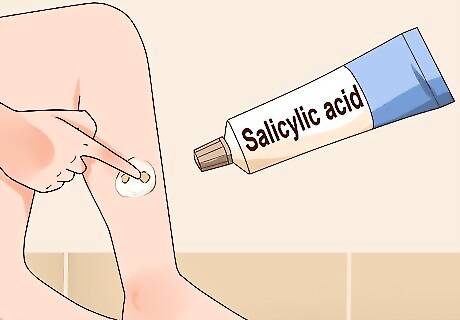
Use Salicylic acid. Salicylic acid acts by breaking up and killing the cells infected by HPV. Instead of attacking normal cells as well, the acid leaves the normal cells alone. Buy Salicylic acid, such as Compound W or Dr. Scholl's Clear Away, at your local drugstore as a patch or a liquid. Wash the area well and dry it. Apply the patch or liquid as directed. Repeat daily until the wart is gone. This can take 2-3 months. Avoid getting the medicine on any other portion of your skin. To help the acid work better, soak and file down your wart so the medicine can soak deeper into your skin. You can get a stronger concentration of Salicylic acid by prescription.
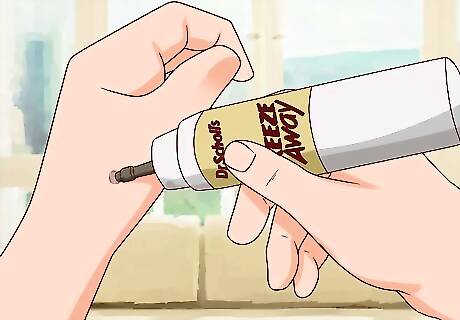
Try to freeze the wart. Over-the-counter freezing medicines use dimethyl ether and propane to freeze the skin of the wart. The medicine essentially freezes the wart and kills the skin, causing it to fall off. Freezing medicines, such as Compound W's Freeze Off or Dr. Scholl's Freeze Away, can be purchased at your local drugstore. Follow the manufacturer’s instructions. They can take up to 2 months to work. Keep the medicine away from any open flame. The FDA warns that these medicines may be flammable. A recent study has suggested that the freezing method may be more effective in getting rid of warts within 2 months.

Try the duct tape method. The duct tape method, also known as tape occlusion, is a tried and true home remedy that many people swear by. It is not known how the duct tape works. Some say that the adhesive has a substance that breaks down the skin cells and are then pulled off by the physical action of tape removal. For this method, buy silver duct tape and apply a small piece of the duct tape to the wart. Leave the tape on the wart for 6-7 days. Remove the tape and soak the wart in water. Use a disposable emery board to “file away” the wart. Leave the wart uncovered overnight or up to 24 hours. Reapply the duct tape for 6-7 days. Repeat the process as often as necessary for up to 2 months. You can apply onion or garlic juice on the wart before putting on the duct tape. In one study, duct tape actually worked better that freezing the warts off.
Understanding Warts

Recognize a wart. A wart is a skin growth caused by Human Papilloma Virus (HPV). The warts can appear anywhere on your body. However, they only infect the top layer of skin. Common warts mostly tend to be found on the hands and plantar warts are found on the soles of the feet.

Understand transmission of HPV. The HPV virus can be easily passed from one person to another. You can also re-infect yourself by touching your wart and then touching another part of your body. Warts can also be spread by sharing towels, razors, or any other personal items that come into contact with the wart. Some people seem more likely to get warts than others. You are at higher risk for warts if you have a suppressed or less effective immune system.
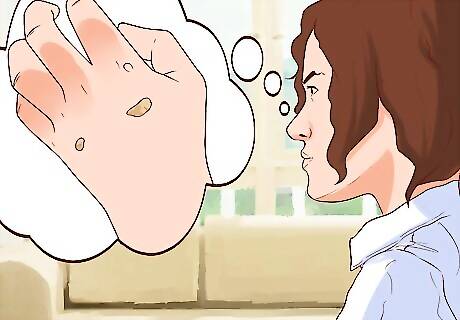
Know the symptoms. Warts are generally an elevated bump on the skin with a roughened surface, though some warts are flatter and smoother. They can come in many different shapes and sizes. Warts tend to be painless, though some plantar warts that can make walking difficult. Warts on the fingers can also be uncomfortable because they are used and irritated more frequently. Generally, warts can be diagnosed by a physician without a skin sample based on where they are and what they look like.
Distinguish the kinds of warts. Common warts can be spread to the genitals or the rectal area, but common warts are usually caused by a different type of HPV than genital warts. The common wart is not associated with a higher risk of cancer, while many genital warts are. Make sure you see your healthcare professional to make sure you are dealing with a common wart. If you have warts around your genitals or around your anus, you should see your physician to determine what specific form of virus is causing the warts.
When to Seek Medical Attention
Talk to your doctor if you’re not sure your bump is a wart. If the growth might not be a wart, treating it as one can make it worse or cause potential health issues. It’s best to visit your doctor for a diagnostic exam to make sure your growth is a wart and receive proper treatment. Keep in mind that some skin cancers can look like a wart, so it’s important that you’re sure what you have is actually a wart.
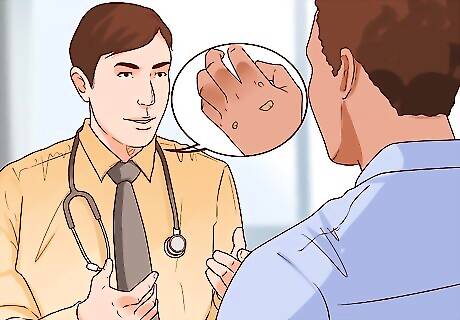
See your doctor if your wart is painful or bleeding, changes in appearance, or bothers you. Most warts have no symptoms, so you need to talk to your doctor if your wart is hurting, itching, or interfering with your daily activities. They can make sure your growth is actually a wart. Then, they can offer you treatment options for getting rid of the bump quickly. As an example, a wart might interfere with your daily activities if you have trouble gripping a pencil or pen because of a wart on your finger. This would make it hard to write. Changes in appearance might include getting larger, surface changes, or color changes. If your wart is changing, it’s possible that it may actually be skin cancer, so it’s best to get it checked by a doctor.
Get medical treatment for warts that persist or spread. Some warts don’t respond to home treatments. If you have a stubborn wart that just won’t go away, you may need medical treatment. Similarly, your doctor can help if you start developing additional warts, whether in the same location or on different parts of your body. In rare cases, you may have multiple warts appear on your body at the same time. If you’re an adult and this happens, see your doctor to find out why. It’s possible your immune system is having an issue.
Visit your doctor if you have diabetes or a poor immune system. This is especially important if you have nerve damage caused by diabetes. Your doctor can monitor your wart and make sure you’re getting the proper treatment. It’s very difficult to get rid of warts if you have a poor immune system, since your body can’t fight the wart virus as well. Medical treatment can help. In some cases, you may have poor sensation in your hands and feet due to diabetes. If this is the case for you, you may not notice pain or injury to the wart during treatment, which can occur if the treatment is applied incorrectly.
Ask your doctor about your treatment options. Your doctor can treat the warts in their office or may prescribe wart medication for you to use at home. Which treatment they recommend will depend on your preferences, the type of wart you have, the previous treatment methods you’ve used, and where the wart is located. Here are the typical treatments used for warts: Prescription-strength salicylic acid removes the wart layer-by-layer. Your doctor may prescribe this treatment alone or with cryotherapy. Cryotherapy involves freezing the wart with liquid nitrogen. A blister will form under and around the wart, which helps slough off the wart. However, you may experience discomfort, discoloration, and blistering. Trichloroacetic acid can be used in office to treat the wart after your doctor scrubs off the top layer of skin. This treatment can cause discomfort and may require several applications. Your doctor likely won’t recommend it unless nothing else works. Surgery can remove a wart that is really bothering you, such as one on your face. Your doctor will cut away the wart, which may result in minor scarring. Laser treatments can cut off blood supply to the wart, causing it to die. However, this treatment may cause discomfort and scarring.


















Comments
0 comment